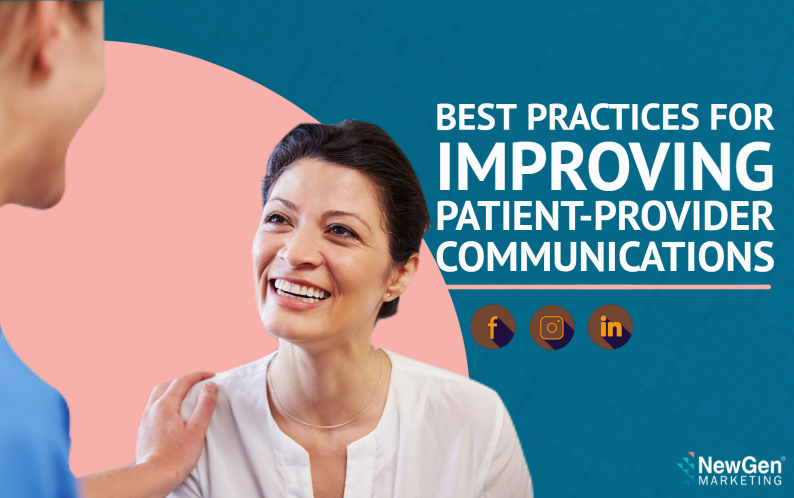Establishing a trusting relationship with your patients is a primary care goal for you as a provider. An engaging and communicative patient-provider relationship leads to better care plan adherence, fewer miscommunications and errors, better clinical outcomes, and improved patient satisfaction.
Implementing good communication methods is a foundational step for building rapport, trust, and mutual respect between you and the patients you serve. Below, we go over some best practices to incorporate into your patient interactions and improve patient-provider communication.
1. Utilize the Patient Portal
A patient portal is an amazing tool to improve patient engagement and give patients a direct, open line of communication to their care teams. Research shows that when patients can access all their health records and care plans, schedule new appointments, and request medication refills in a single place, they are more likely to adhere to treatment plans and manage chronic conditions better.
Additionally, a portal provides patients with a safe and direct way to communicate with their care teams via secure email. Reaching a care team member between doctor’s appointments is a major pain point for patients. Often, they become frustrated playing phone tag trying to connect with their nurse, PA, or physician. With an open line of communication, your patients are more likely to reach out with issues or concerns between visits, instead of failing to address a problem until the next appointment.
You can help empower patients to use the portal by endorsing it during visits and ensuring that patients know how to access it, how to perform tasks like viewing test results or requesting refills, and how to reach out to you and the rest of the care team when they need assistance.
2. Review the Patient Chart Before an Appointment
Take a few minutes to skim a patient’s chart before an appointment, not while you’re walking through the door to their room. That time would be better spent giving a warm greeting and focusing your full attention on the patient instead of the papers in your hand.
Reviewing charts is easier when your practice has a robust health care CRM that gives you a 360° view of every patient in one place. At a glance, you can view the current treatment plan, prior visit notes, and issues or concerns that require a follow-up during this visit. Walking into the appointment room prepared helps your patients feel like they’re getting the care and attention they need from you.
3. Include the Patient in Care Coordination
Don’t talk at your patients the entire appointment — talk with them instead. Patients are more likely to adhere to care plans when they understand your rationale behind prescribing treatments, therapies, and medications. During visits, practice narrating your care in simple language that your patients comprehend. When you include your patients in the care coordination process, they’ll feel more empowered to take ownership over their health and well-being.
4. Actively Listen
Above all, your patients want to feel acknowledged, heard, and reassured. One way you can connect better with patients is to sit down, push paperwork to the side, and actively listen to your patients describe how they’ve been, what steps they’ve taken to improve their health, new issues or symptoms, and any concerns they have. Accepting and engaging with this patient-generated health information will help you coordinate better care based on an individual’s unique needs.
Additionally, active listening will help you build rapport and trust with your patients, leading to a more positive patient-provider relationship.
5. Take an Empathy-First Approach
Every communication with your patients should be guided by empathy, compassion, and sensitivity. For many, the doctor’s office is not a place they feel at ease — your patients are probably anxious, scared, uncomfortable, or even angry during appointments. Validating their concerns and offering guidance and reassurance will go a long way toward building a long-term relationship with your patients.
One way to practice empathy is to perform the BATHE technique, a patient-centered assessment that taps into your patients’ headspace during visits. BATHE involves asking four questions and following up with an empathetic response.
- B — Background: “What is going on in your life?”
- A — Affect: “How do you feel about that?”
- T — Trouble: “What troubles you the most about this?”
- H — Handling: “How are you handling that?”
- E — Empathy: “That must be very difficult for you.”
Over time, consistently practicing the BATHE technique will help you remember to slow down and lead with empathy during patient visits.
6. Ask for Feedback
Don’t be afraid to ask your patients for honest feedback about your communication techniques and bedside manner. Through your health care CRM, you can automate post-appointment surveys via text or email that ask patients to rate their overall experience and satisfaction with you as a provider. Although it can be difficult to receive critical feedback, you’ll ultimately become a better provider by striving to improve the way you communicate and connect with the patients you serve.
Learn More About NewGen Marketing
The NewGen Marketing team has years of experience driving sales and business growth for industry-leading health care brands. We recognize the value of integrating multi-channel marketing campaigns with a proven acquisition and nurturing process that turns leads into patient conversions and treatments.
We provide broad-spectrum medical marketing services, including strategy and investment, analytics, paid media, social media, remarketing, content marketing, and acquisition and call centers. When you’re ready to hire a marketing agency that can drive more to your bottom line, contact NewGen Marketing for a free consultation.

